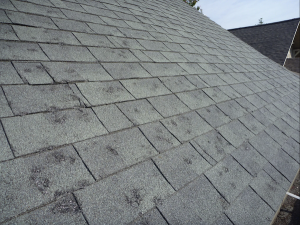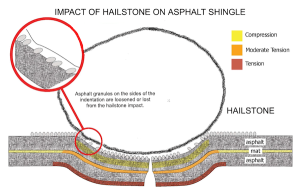One of the crazier things a Connecticut Homeowner can endure is a mid-summer hail storm. You’d never think to see ice falling from the sky in early July but that’s exactly what a hail storm is and it can be as damaging as it is surprising. When this happens, you need a Hail Damage Inspection.
The first step after evaluating your family and pets for injury and inspecting your vehicles and grounds for damage is to turn to the roof of your home. You need to examine your roof for both obvious but also  somewhat hidden issues: damage from hail to a roof can be stealthy and invisible from the ground.
somewhat hidden issues: damage from hail to a roof can be stealthy and invisible from the ground.
If you’ve witnessed golf ball-sized hail or larger, you will no doubt see obvious signs of damage and destruction to the siding, gutters, or windows of your home. In these situations, there is little doubt that the roof of your home has also experienced some level of damage.
A Hidden Threat to Roof Integrity
However, when the hail is smaller – closer to dime or quarter-sized hailstones, detection of damage from the ground level is almost impossible to assess and often difficult to uncover when you are up on the roof unless you know what to look for.
So the first step is to get up on the roof. Unless this is something you do on a regular basis, it is not advisable for you to do so, particularly with a tiled, shingled or metal roof. If the storm has just happened it will be naturally slippery. Also, loosened tiles or metal can be dangerous to walk on and, if the damage has permeated to and therefore weakened the roof deck, it may be obscured by damaged tiles.
 Instead, contact us. We know exactly what to look for and will provide a Hail Damage Inspection and Assessment absolutely free of charge. We know what to look for when it comes to both obvious hail damage – hailstone-sized cavities in shingles, dents in metal, cracks in tile or slate. But more often than not, you need to detect the less obvious but equally concerning byproduct of hail damage: asphalt roof shingle granules that have been compressed and or knocked off their shingles and into the gutters.
Instead, contact us. We know exactly what to look for and will provide a Hail Damage Inspection and Assessment absolutely free of charge. We know what to look for when it comes to both obvious hail damage – hailstone-sized cavities in shingles, dents in metal, cracks in tile or slate. But more often than not, you need to detect the less obvious but equally concerning byproduct of hail damage: asphalt roof shingle granules that have been compressed and or knocked off their shingles and into the gutters.
When the granules are knocked off, asphalt shingles can appear shinier to the naked eye. If after a storm your roof appears shinier in places, it’s definitely time to call us. But keep in mind with this damage, it’s often not detectable until you are up on the roof.
Hail Damage Doesn’t Go Away
While the dents in a metal roof will look unappealing, and in some cases the damage can compromise how the roof is affixed to your home, hail damage to shingles and tile can impact the life of your roof. Shingles that lose their asphalt granules don’t stand up as well to the expansion and contraction of heating and cooling. They tend to get more brittle more quickly which makes them susceptible to wind and water damage. And because they aren’t as well-sealed, they open the underside of your roof and roof decking to moisture and water damage which is what your roof is meant to prevent in the first place.
Once you understand the extent of the damage, take a deep breath, and then contact your insurance company. Most homeowner’s insurance covers hail damage to roofs; we will provide a formal written estimate which you can submit in advance of our beginning our work. They may schedule an inspector of their own to come to assess the damage; if this is the case and your roof requires it, we can make sure it’s protected with weather coverings over the damaged areas.
Keep in mind that if your roof has any vents or other fixtures, these too will likely require repair or replacement. What may not seem like much damage to a roof (may not be apparent to you), may actually be significant, and that’s why a trained professional is necessary for proper assessment.
If you have experienced Hail Damage and are in need of an emergency inspection or repairs, please contact us at your convenience.
